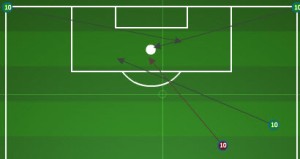In Seattle’s 2-1 loss to Portland on Saturday, Clint Dempsey took all of the Sounders’ attacking set-pieces in the first half. He was impressive with his free kick shots on goal, clipping the crossbar and forcing Donovan Ricketts into multiple saves. But his corner kicks left much to be desired. Mauro Rosales subbed on in the 63rd minute and took the remainder of the set-piece crosses and created more chances.
With Lamar Neagle suspended for yellow card accumulation and Seattle needing goals in leg two, Rosales seems likely to start. Requisite warning about small sample sizes aside, based off of the results in leg one, the data suggest Sigi Schmidt would be wise to let Rosales take over set-piece crossing duties in the second leg.
Here's how Dempsey’s nine corners and one free kick cross went in leg one:

3rd minute corner: To the near post, cleared by Diego Chara
6th corner: Near post, cleared by Will Johnson
20th corner: Near post, cleared by Will Johnson
25th corner: Near post, cleared by Chara
32nd corner: Near post, cleared by Chara
38th corner: Top of the six yard box, cleared by Pa-Moudou Kah
38th corner: Top of six, cleared by Kah
39th free kick: Cross from 18 yards out on the wing to the top of the six, cleared by Futty Danso
45th corner: Near post, punched clear by Ricketts
In the second half, Rosales took all three Seattle corners and two free kick crosses:

68th minute corner: To the penalty spot, shot by Djimi Traore, saved by Ricketts
69th corner: Top of six, Headed cross by Dempsey blocked by Zemanski and eventually caught by Ricketts
82nd free kick: Cross from 38 yards in the center to the penalty spot, cleared by Danso
86th free kick: Cross from 28 yards on the wing to the edge of the penalty box, headed by Shalrie Joseph across the box
87th corner: Penalty spot, Headed shot by Dempsey off of the crossbar and out
In summary: Dempsey had 10 set-piece crosses, none of which reached a Seattle teammate. Rosales had five set-piece crosses, four of which found a teammate in the box, and three of which led to shots.
As you can tell, it was a tale of two halves. In the first, Dempsey’s crosses rarely cleared the first defender, and none found another Sounders player. In the second half, four of Rosales’ five crosses created chances, two off of the head of Dempsey himself.
If Seattle is going to win at Jeld-Wen Field on Thursday, they’ll need to do better with their crosses. Based on their chances in game one, it looks to be in the Sounders' best interest to allow Rosales to take the free kick crosses in game two. Not only did his crosses create better chances than Dempsey in game one, but Deuce seems to be more dangerous getting on the end of crosses than he is at taking them.




